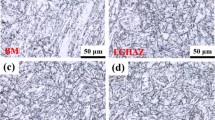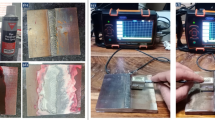Abstract
P91 steel weld joints made by multipass welding greatly alters the initial microstructure of the base metal and a thermally graded microstructure builds up across the weld joint due to its thermal sensitive nature. More so, when the weld joint is subjected to simultaneous cyclic loading and creep deformation, the initial microstructure of not only the base metal but also each constituting microstructural zone of the weld joint varies in a very complex manner depending upon the cyclic waveform employed. Four test conditions that represent four types of cyclic loading waveforms have been chosen for the present study. These are samples that were subjected to pure fatigue (without application of dwell), and samples that were exposed to an additional dwell period applied in each cycle at peak tension or peak compression or both peak tension and compression (represented as CC, 30 TH, 30 CH and 5 TCH respectively). All experiments were performed at 873 K and at 3 × 10−3 s−1 strain rate using total strain amplitude of ± 0.6%. Failure location shifted with the applied waveform. Microhardness line profiles on the longitudinal section of the fatigue failed samples were obtained at an inter-distance of 0.2 mm. The first-hand information obtained using this technique indicated that hardening/softening of the constituting regions of weld joint occurred to different extents and that was also waveform dependent. The microhardness correlated well with dislocation density obtained through EBSD.






Similar content being viewed by others
References
Aoto K, Komine R, Ueno F, Kawasaki H, Wada Y (1994) Creepfatigue evaluation of normalized and tempered modified 9Cr-1Mo. Nucl Engn Design 153:97–110
ASTM Standard E606/E606M (2012) Standard test method for strain-controlled fatigue testing. Doi: https://doi.org/10.1520/C0033-03
Badji R, Chauveau T, Bacroix B (2013) Texture, misorientation and mechanical anisotropy in a deformed dual phase stainless steel weld joint. Mater Unfoiled 575:94–103
Benjamin F, Maxime S, Alexandra R, Françoise B, André P (2009) Microstructural evolutions and cyclic softening of 9%Cr martensitic steels. J Nucl Mater 386–388:71–74. https://doi.org/10.1016/j.jnucmat.2008.12.06
Farragher TP, Scully S, O’Dowd NP, Hyde CJ, Leen SB (2014) High temperature, low cycle fatigue characterization of P91 weld and heat affected zone material. J Press Vessel Technol 136:2. https://doi.org/10.1115/1.4025943
Hollner S, Fournier B, Lependu J, Caes C, Tournie I, Pineau A (2010) Relationship between microstructure and mechanical behaviour ofthermomechanically optimised 9–12% Cr steels. In: Fracture of materials and structures from micro to macro scale, ⟨hal-00541091⟩
Kim S, Weertman JR (1988) Investigation of microstructural changes in ferritic steel caused by high temperature fatigue. Metall Trans A 19A:999–1007
Klueh RL (2005) Elevated temperature ferritic and martensitic steels and their application to future nuclear reactors. Int Mater Rev 50(5):287–310
Lord DC, Coffin LF (1973) Low cycle fatigue hold time behavior of cast rené 80. Metall Trans 4:1647–1654. https://doi.org/10.1007/BF02666191
Mariappan K, Shankar V, Bhaduri AK (2020) Comparative evaluation of tensile properties of simulated heat affected zones of P91 steel weld joint. Mater High Temp 37(3):1–15
Morris J (2001) The influence of grain size on the mechanical properties of steel. Lawrence Berkeley National Laboratory. Accessed from https://escholarship.org/uc/item/88g8n6f8
Panait CG, Zielinska-Lipiec A, Koziel T, Czyrska-Filemonowicz A, Gourgues-Lorenzon A-F, Bendick W (2010) Evolution of dislocation density, size of subgrain and MX-type precipitates in a P91 steel during creep and during thermal ageing at 600°C for more than100,000. Mater Sci Eng 575A:94–103. https://doi.org/10.1016/j.msea.2013.03.018
Pandey C, Mahapatra MM, Kumar P, Kumar S, Sirohi S (2019) Effect of post weld heat treatments on microstructure evolution and type IV cracking behavior of the P91 steel welds joint. J Mater Process Technol 266:140–154. https://doi.org/10.1016/j.jmatprotec.2018.10.024
Sarkar A, Vijayanand VD, Parameswaran P, Vani Shankar R, Sandhya K, Laha MD, Mathew TJ, Rajendra Kumar E (2014) Influence of prior fatigue cycling on creep behaviour of reduced activation ferritic-martensitic steel. Metall Mater Trans A 45(7):3023–3035. https://doi.org/10.1007/s11661-014-2237-x
Shankar V (2007) PhD thesis titled: Low cycle fatigue and creep-fatigue interaction behavior of modified 9cr-1mo ferritic steel and its weldment, IIT Madras
Shankar V, Sandhya R, Mathew MD (2011) Creep–fatigue-oxidation interaction in Grade 91 steel weld joints for high temperature applications. Mater Sci Eng A 528:8428–8437
Shankar V, Mariappan K, Sandhya R, Mathew MD, Jayakumar T (2014) Effect of application of short and long holds on fatigue life of modified 9Cr-1Mo steel weld joint. Metall Mater Trans A 45A:1390–1400. https://doi.org/10.1007/s11661-013-2108-x
Thomas Paul V, Saroja S, Hariharan P, Vijayalakshmi M (2007) Identification of microstructural zones and thermal cycles in a weldment of modified 9Cr1Mo steel. J Mater Sci 42(14):5700–5713. https://doi.org/10.1007/s10853-006-0704-5
Thomas Paul V, Saibaba S, Vijayalakshmi M (2008) Microstructural stability of modified 9Cr–1Mo steel during long term exposures at elevated temperatures. J Nucl Mater 378:273–281
Wang Y, Li L (2016) Microstructure evolution of fine-grained heat-affected zone in type IV failure of P91 welds. Weld J 95(1):27–36
Wang Y, Kannan R, Li L (2018) Correlation between intercritical heat-affected zone and type IV creep damage zone in Grade 91 steel. Metall Mater Trans A 49A:1264–1275
Yadav SD, Kalácska S, Dománková M, Yubero DC, Resel R, Groma I, Beal C, Sonderegger B, Sommitsch C, Poletti C (2016) Evolution of the substructure of a novel 12% Cr steel under creep conditions. Mater Charact 115:23–31
Acknowledgements
The authors are thankful to Indira Gandhi Centre for Atomic Research, Kalpakkam and Homi Bhabha National Institute, Mumbai for providing the opportunity to carry out this research.
Author information
Authors and Affiliations
Corresponding author
Additional information
Publisher's Note
Springer Nature remains neutral with regard to jurisdictional claims in published maps and institutional affiliations.
Rights and permissions
About this article
Cite this article
Vaishali, P., Shankar, V. Unraveling the Complexities of Deformation/Damage Incurred in P91 Steel Weld Joint During Creep–Fatigue Interaction Loading at 873 K. Trans Indian Natl. Acad. Eng. 7, 699–706 (2022). https://doi.org/10.1007/s41403-022-00319-1
Received:
Accepted:
Published:
Issue Date:
DOI: https://doi.org/10.1007/s41403-022-00319-1




